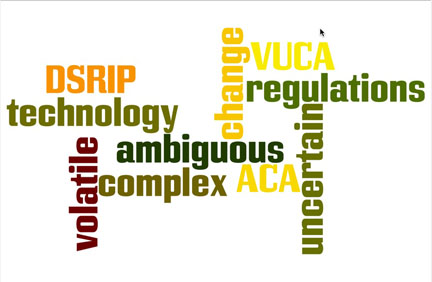A VUCA environment is volatile, uncertain, complex, and ambiguous. Sound familiar? Welcome to the healthcare world in which we are now operating.
The concept of VUCA was introduced by the U.S. Army, and got traction in the business community in the early 2000’s, when leaders began using it to describe a business environment that was changing rapidly, due to lightning advances in technology and ongoing uncertainty and turbulence in the global economy.
Changes in technology have helped turn the healthcare industry into a VUCA environment as well. So have regulatory changes like the Patient Protection and Affordable Care Act, also know as the ACA or Obamacare, and New York State’s Delivery System Reform Incentive Payment (DSRIP) Program. These new programs are dramatically shifting the way healthcare quality is measured and how healthcare services are paid for, awarding greater incentives for keeping citizens healthy.
Industry experts warn us that constant change is becoming the “new normal,” and the healthcare landscape will look very different in five years than it does now.
So how can we function effectively in a VUCA environment? Kirk Lawrence of University of North Carolina’s Kenan-Flagler Business School writes about “VUCA Prime,” a concept developed by Bob Johansen of the Institute for the Future. This approach offers strategies, skills and abilities including the following:
VOLATILITY can be countered with VISION. Maintaining a clear vision can help to better weather environmental changes.
UNCERTAINTY can be countered with UNDERSTANDING. This includes open communication lines throughout an organization as well as good teamwork and collaboration.
COMPLEXITY can be countered with CLARITY, which allows one to make sense of chaos and make informed decisions.
AMBIGUITY can be countered with AGILITY, allowing one to communicate across an organization and to move quickly to apply solutions.
In a Harvard Business Review series, Colonel Eric G. Kail also writes about effective ways to work in a VUCA environment. Among them are:
| Volatility | Uncertainty | Complexity | Ambiguity |
|
|
|
|
